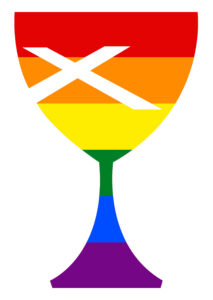Our Story
The church was organized in 1845 with these six charter members: Stephen Hackney and his sister Sallie; William Payne and his daughter Mary, Mr. Bailey, brother-in-law to William Payne, and Mr. Saunders. The church was known as the Church of Christ. They did have instrumental music.
They met in a house owned by Jacob Vanmeter located on the northeast side of College and Center Street. Vanmeter was a big land owner and a slave owner. There is no indication he was in the church. They met to read scripture, to pray, to give an offering and to observe the Lord’s supper.
The Church built their first building on what is now Center Street between 7th and 8th avenues. That building is still used by the Cecilia Presbyterian church. They stayed at that location until 1879. Mr. Payne was the donor of property and that church was “free to all Christians when not in occupancy and use by this Church.” (Remains so today.)
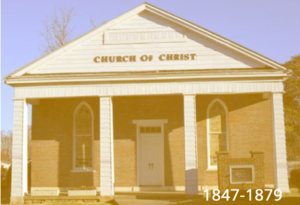
Ministers at the first church
1847-48 The first Minister was John Newton Mulkey. He began preaching while living in Tennessee. He was a Baptist and came to Mill Creek Baptist near Thompkinsville. He was speaking in a home on the subject of predestination when he fell under conviction of his own sermon and decided he was wrong. He became a part of a new moment led by the Campbells and Stone. It split the church. About half of the members went with him and the church they began meeting in still stands and is known as the old Mulkey Meeting House. Among those who went with him in establishing this church was the sister of Daniel Boone who is buried next to the church.
Mulkey was said to have preached 2 ½ hour sermons holding the bible in his right hand and gesturing with his left hand. His first sermon was preached in 1831 and was entitle “The Weekly Meeting of Church to Break Bread.”
John Mulkey started the Christian Church in Glasgow before coming to serve for about 1 ½ years as the first pastor of our congregation. After serving our church he was elected by a collection of churches to be chief evangelist for Warren County Co operation, a movement of churches working together to spread the good news. It wasn’t unusual for meetings he led to have over 100 converts. He left six years later and went to Hancock County in Illinois. He died at 7:25 on Sept. 26 in 1882.
He was in ministry 53 years and delivered nearly 10,000 sermons.
Phillip Fall was the second minister for the church. He was born in England and ordained a Baptist. Inspired by the writings of Alexander Campbell, in 1824 he began encouraging Baptists to put away their creed. He started the Female Eclectic Institute in Frankfort which provided education for women.
R.C. Flower was at the church for a short time. Later he withdrew from disciples in 1877 because he felt anyone who had been baptized no matter the mode should be welcome in the church. “No man has a right to put up his opinions as infallible.”
Jonathan Martin Streator was the first pastor to have been educated at Bethany College which was started by Alexander Campbell. He was pastor in three towns in PA, in Syracuse NY, in Helena Montano, in Danville Ky, in New Orleans and in Matton, IL before becoming professor of Latin at Bethany.
Matthew Ferguson was pastor from 1877-88. He was the first longer serving pastor. Seven pastors served the church in her first 20 years. Under his leadership the church moved from its first building and constructed a second sanctuary.
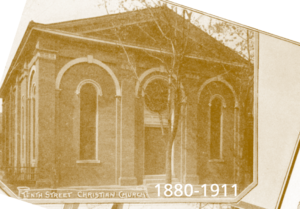
Second Sanctuary: The church bought a house and lot in 1880 on Tenth Street right behind where city hall is today. They changed their name to Tenth Street Christian church. There were twelve Ministers from 88-98. In 1895 there was a fire that did extensive damage to that building. Then in 1896 trouble that had been going on for a few years concerning the use of an organ came to a head and the church split. The 12th Street Church of Christ was started. Following this difficult time two ministers stayed for longer times, C K Marshall followed by William Wells , providing some stability. Tragedy struck again in 1911. E. J. Fenstermacher who had been pastor at the church for three years left the first of July in 1911. On July 5 a fire broke out at Paterson and Patterson Livery stable and quickly destroyed several buildings. Bowling Green city hall, a residence then, sustained damage. Our building was gutted. We had no minister and first met at Cumberland Presbyterian church and had prayer meeting on Wednesdays at the YMCA. Then the church went to the courthouse and began meeting in the courtroom.
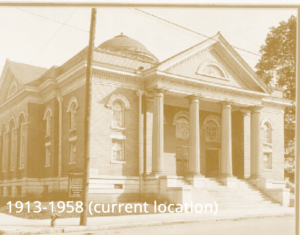
Third Building: The church had put money down on land before the fire in 1908 at the present site on State Street. The burned out building on Tenth St was sold to Times Journal printing and Publishing company for $2500. $2000 was received from the insurance settlement. The Policy had been valued at $5000. August 6, 1911, was named Christian Church day in Bowling Green. A total of $14000 was raised in subscriptions. The church began work on its new building in Nov 1911, and laid the cornerstone in July 1912.
They hired a pastor, B. F. Cato in Jan of 1912.
On May 11, 1913, the church was dedicated with 1200 people present. The name of the church was changed to First Christian Church. The total cost of the lot and building was $34000. Before the building was complete $24,000 had been raised. $7300 was raised on dedication Sunday leaving only $2700 in debt. It took eleven years to pay off that $7300. In 1920 the church spent $4000 for decorations and lighting. During those renovations the church couldn’t meet in the sanctuary. The Cumberland Presbyterians were without a minister so they met together.
B.F. Cato came at the beginning of 1912 and stayed until 1915. During his ministry the church grew. The church honored him when he left with a decree saying he, “Came to us in a trying time when we had an extensive building enterprise on hand, he has not only met every requirement but he has built up and greatly strengthened both the church and Sunday school and he leaves us stronger, broader, and on a more enduring foundation than when he came to us.”
Leroy Anderson followed Cato and served for a year and started a weekday education program for children that was popular.
The first long serving pastorate began when AB Houze came in 1917 and stayed until 1945. He was a graduate of Transylvania and College of Bible. He was 47 when he came as pastor of the church and he stayed until he was 75. He was very sick the last few months of his ministry. It was said of him, “He drives a Mitchell car and manages to keep just within the speed limit. He might get in trouble at times if it were not for the fact that the chief of police is a member of his men’s class.” There were annual calls for the minister at that time. That meant the church had to vote each year to extend the minister’s call. In 1928 Houze was given a life call which meant he wouldn’t have to be voted on every year. He was called the Dean of Protestant Ministry in BG. During his ministry 1255 people were added to church roles. When he retired he was named Minister Emeritus, the first in the church’s history. Several times during his ministry the church wasn’t able to pay him his salary. Several times he canceled the debt owed him by the church. When he retired the church paid him back money that was due. He died in 1954.
He was followed by James Lollis. He was a well educated, progressive minister. He once wrote, “A made up mind in a world that doubles its knowledge each ten years is a genuine example of concrete thinking. One’s mind, like one’s bed, should be messed up and made up again every day.” He began the work of opening the church up to women in leadership. In 1946, he led the church to change its policy on women on the board. Then in 1948 he led the church to hire its first associate, responsible for religious education. He hired Mary Holda Allen.
Allen had grown up in the church, taught in Eastern Ky and gone to College in the Bible. She ended up going to Douglas Blvd in Louisville and then to Danville, FCC after leaving our church. Then she went to FCC Mt Carmel, IL and on June 19, 1960, she was ordained. She was the first woman who grew up in our church who was ordained. She served as pastor of FCC in Waynesboro, TN for 11 ½ years. James Lollis left in 1951, and went to FCC in Danville, KY. Then in 1958, he went to Lexington as the founding pastor of Crestwood Christian Church.
Jean Stewart Wake served as pastor from 1951-57. He graduated from Lynchburg College and College of Bible. He went on to serve in Norfolk, Va, Peoria, Il and Wilson, NC. He retired in 1985 after 43 years in ministry. During his ministry in BG the church purchased the property and built the education building. That is the oldest structure on our present campus. It was dedicated on Nov 25, 1956. In the basement was a fellowship hall and on the second floor were rooms for children’s Sunday School.
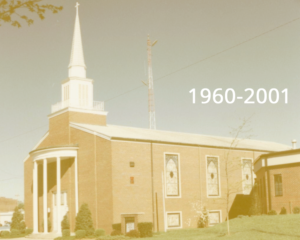
Reed Carter came to serve the church at the end of August 1957. There were only six weeks time between he and Wake. Reed was a graduate of Bethany College and College of the Bible. He had served at Dover Place Christian Church in St Louis for five years. He was just 29 years old when he came to serve our church. Less than a year after he arrived, on June 22, 1958, the dome on the sanctuary slipped. It became unsafe and the cost of repair was too great. After much study and deliberation the church decided to tear the sanctuary down and rebuild. Contractors razed the building in Dec 1958, and began construction in 1959.
On May 17, 1959, the church celebrated paying off the mortgage on the education building and they bought the Moore property for $34,000. They began construction in August of 1959, on a new sanctuary. Nashville Co M & S Construction got the contract and the estimated cost would be $200000. They had trouble with lots of rock that had to be blasted. When the Sanctuary was nearing completion a fire was set by a Boy Scout April 28, 1960. Damage caused the church to put up paneling covering the ceiling and laminated beams. The loss was $30000. Insurance covered about half of that amount. The first meeting in the new sanctuary was held on Sept. 11, 1960. The new Sanctuary was dedicated in October and Dr. Wake came back to preach the sermon. The sanctuary was air conditioned, seated 500, had classrooms under the sanctuary and new offices for the pastor. The cost for the sanctuary including furnishings and a refurbished organ was $187,410.20. The mortgage was paid off and burned April 28, 1974.
In 1984 stained windows were put in. In 1988 the church began planning a new fellowship Hall and office space. The cost was to be $921,900. In 1989 the church purchased two houses on Chestnut from Graves-Gilbert Clinic for $75000.
Reed Carter retired in August 1990 and was elected Minister Emeritus. After living in Hopkinsville, KY for two years, he and his wife Elaine moved back to Bowling Green where he served as chaplain at Greenview Hospital for several years. He died September 9, 2004.
The new addition to the church which included new office space and a fellowship hall was completed in 1991. It was named for Reed and Elaine Carter.
Ed Coffman came and served as interim. Bob Franz came in 1991. He resigned in June of 1995. David Blondell followed as interim.

John P. Wesley began his ministry at First Christian the beginning of June 1996. He had served previously for 12 years as senior minister of First Christian Church in London, KY. In 1996, the church bought another apartment on Chestnut Street. In 1998, the church built a garage for the church van on the back side of that property on Chestnut St. In 2001 the church began remodeling the sanctuary. The work changed the appearance of the sanctuary and added a glass Narthex leading to the sanctuary on the southwest side of the church. That work was finished in May of 2002, at a cost of $1.2 million. In 2005 the church added a new floor in Carter Hall that included a Chartres labyrinth. In 2008-09 the apartment houses on Chestnut were torn down and the parking lot was constructed. A drive-through was added to the church and doors were added in the Narthex outside Carter Hall. The cost of the project was just over $400,000. In 2010-11 the church remodeled the youth room adding a bathroom and showers and a small kitchen. In 2012-13 the church remodeled the educational space under the sanctuary.
In 1997 the church established a permanent fund policy to receive estate gifts. The fund was set up as a way to ensure maintaining the corpus of all gifts while using income from the gifts to enlarge the congregation’s ministries. Each year income from the permanent funds is distributed according to this formula: 40% used for local outreach, 30% used for Capital expenditures, 15% used for regional or general ministries and 15% used for the general Fund. Starting with around $200,000, the permanent fund and trust funds have grown to over $3,000,000.
Rev. John P. Wesley retired from First Christian Church June 30, 2014.
The Rev. Megan Huston has served as senior minister since then.
Written by the Rev. John Wesley, pastor emeritus
